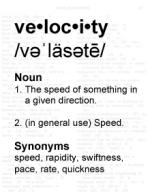|
This section contains 239 words (approx. 1 page at 300 words per page) |
Instantaneous velocity is the vector expression of the speed an object is moving at any given second. That is, it takes into account both how fast the object is moving and in what direction. Instantaneous velocity can be calculated by taking the derivative of the position with respect to time and evaluating the answer at a known time.
Most of the time, average velocity is used rather than instantaneous velocity in everyday applications. For example, a speedometer in an automobile does not have an abstract position function, of which it would take the derivative. Instead, it measures the distance traveled in fractional amounts of time and reports the speed of the automobile as a time average on a very short time. For the velocity reported to truly be the instantaneous velocity, the time frame would have to become infinitesimal.
However, the instantaneous velocity can be found in situations where the position function is well known. For example, an object in free-fall can easily have its instantaneous velocity determined, since the equation for its position as a function of time is well known. In quantum mechanical applications, the instantaneous velocity is involved in the Heisenberg uncertainty relation of position and momentum, and thus it and the position cannot be simultaneously determined if the mass is known. However, in most aspects of physics, the instantaneous velocity is a clear demonstration of the relation of physics to calculus.
|
This section contains 239 words (approx. 1 page at 300 words per page) |


